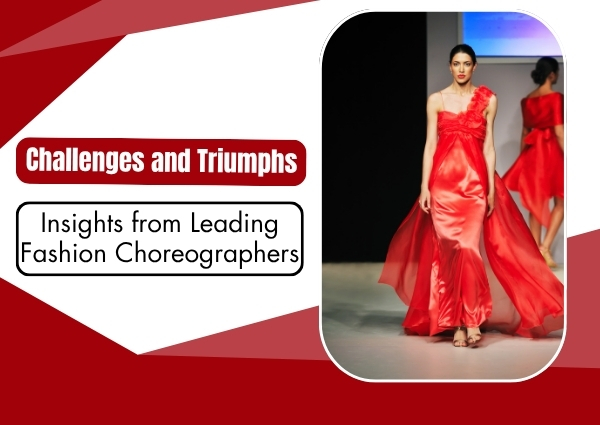Fashion shows are more than just glamorous displays of couture and creativity—they are powerful productions that combine art, music, lighting, and movement to tell a story. At the center of this spectacle stands the fashion choreographer, a visionary professional who brings harmony to designers’ creations and models’ performances.
But behind the flashing lights and applause lies a world of challenges, hard work, and triumphs. From managing last-minute chaos to innovating new presentation styles, leading fashion choreographers continue to redefine how fashion is experienced. In this blog by Babla Kathuria, we explore their journey, their struggles, and their victories.
The Multifaceted Role of a Fashion Choreographer
A fashion choreographer is much more than a backstage manager. They are:
- Strategists who design the show’s flow.
- Storytellers who connect garments to emotions through movement.
- Problem-solvers who handle unexpected mishaps in real time.
- Innovators who continuously experiment with new stage dynamics.
Their ability to synchronize models, music, and set design determines whether the show feels seamless or chaotic.
Challenges That Define the Journey
Even the most celebrated choreographers face hurdles while creating unforgettable runway moments.
- Time Pressure and Tight Schedules
Fashion weeks and brand launches often operate on strict timelines. Choreographers must train models, finalize cues, and coordinate with designers in very little time. One missed rehearsal can throw the entire show off balance.
- Balancing Creativity with Commercial Demands
Designers often want their collections showcased in unique ways, but sponsors and brands may demand a more market-friendly approach. Choreographers constantly walk the fine line between artistic vision and commercial reality.
- Handling Last-Minute Disruptions
From models missing rehearsals to technical glitches in lighting and sound, choreographers face endless surprises. Their calmness and quick decision-making often save shows from turning into disasters.
- Working with Diverse Talent
Not all models have the same level of experience. Leading choreographers must adapt training techniques for both seasoned professionals and newcomers, ensuring consistency on the runway.
- Staying Ahead of Trends
In a rapidly evolving fashion world, choreographers must keep reinventing themselves. Audiences today expect immersive experiences—interactive sets, digital elements, and unconventional catwalks—pushing choreographers to embrace innovation.
Triumphs That Inspire
While challenges test their patience, triumphs fuel their passion.
- Transforming Visions into Reality
One of the biggest joys for a choreographer is watching a designer’s concept come alive on stage. The satisfaction of translating sketches into a live performance is unmatched.
- Standing Ovations and Applause
The moment a show ends with a standing ovation, the choreographer knows every sleepless night was worth it. Audience appreciation is the ultimate validation.
- Launching Careers of Models
Many leading models owe their confidence and runway finesse to choreographers who mentored them. Being part of someone’s success story is a triumph that goes beyond the show.
- Innovating Industry Standards
Choreographers who introduce fresh techniques—like digital runways, immersive sets, or thematic storytelling—leave a legacy that reshapes the industry for years to come.
- Global Recognition
From Paris to Milan, choreographers who work with international brands often see their art celebrated worldwide, solidifying their reputation as trendsetters.
Lessons from Leading Fashion Choreographers
Through their struggles and victories, choreographers share valuable lessons:
- Adaptability is key. Every show brings unexpected changes, and only flexible planning ensures success.
- Teamwork drives results. From light technicians to stylists, everyone plays a crucial role in the final outcome.
- Discipline builds excellence. Repeated rehearsals and structured routines guarantee runway perfection.
- Creativity must evolve. Audiences are hungry for novelty, making innovation the heartbeat of choreography.
The Future of Fashion Choreography
As fashion integrates technology, the role of choreographers is expanding. Virtual fashion shows, augmented reality elements, and AI-based styling are opening new opportunities. Yet the essence remains the same—capturing the soul of fashion through movement and storytelling.
Upcoming choreographers will need to master both traditional stagecraft and digital innovation, ensuring that fashion shows remain as mesmerizing in the metaverse as they are on physical runways.
The journey of a fashion choreographer is filled with obstacles, but every challenge leads to greater triumphs. They are the silent architects behind the magic, balancing creativity, discipline, and resilience to make every show unforgettable.
At Babla Kathuria, we believe in celebrating the artistry of fashion choreography. By learning from their insights, aspiring professionals can prepare themselves for a career that is as demanding as it is rewarding. Because in the end, the true triumph lies not just in dazzling the audience, but in leaving behind an artistic footprint that inspires the future of fashion.

